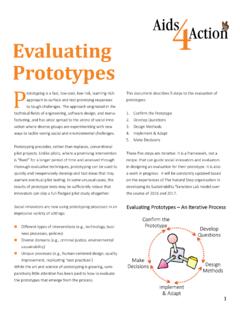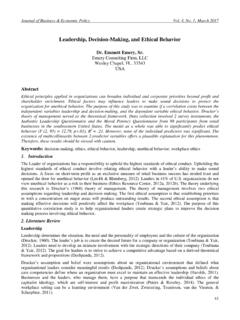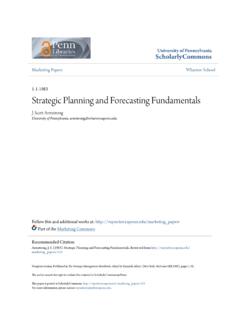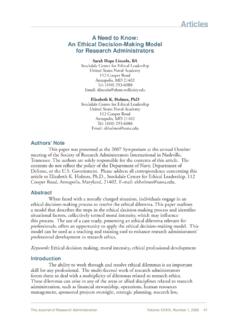Transcription of Practical Guide for Consensus-Based Decision Making
1 TABLE OF CONTENTS What Is Consensus-Based Decision Making ? When to Use the Consensus Model Necessary Conditions Developing Participation Guidelines Procedures for Consensus Decision Making Optional Stances for Participants Comments on Facilitation James Madden London, Ontario Copyright 2017, James Madden Reproduce and distribute freely with citation to author A Practical Guide FOR Consensus-Based Decision Making A Practical Guild for Consensus-Based Decision Making Page 2 WHAT IS Consensus-Based Decision Making ?
2 Consensus-Based Decision Making is based on a deliberate process of consensus building, whereby members of a group actively participate in finding a Decision together that all members can feel comfortable with. A consensus Decision does not necessarily reflect complete unanimity. However, decisions reached by consensus do reflect the thoughts and feelings of the group as a whole1, rather than just the majority. Effective consensus building results in decisions that have been thoughtfully deliberated, incorporate diverse experience and views, and may produce the best possible Decision given the configuration of interests that have come together for a given purpose.
3 The advantage of Consensus-Based decisions as compared with majority rule voting is that it avoids a fundamental problem often associated with voting. Voting may unintentionally result in a split or division in a group, a satisfied majority and disgruntled minority, a sense of winners and losers. Moreover, in the interest of efficiency, there may be a propensity to rush to a vote without full deliberation when opinion seems to be going in a certain direction. The consensus-building process is based on thoughtful, respectful, fulsome deliberation and an intention to find the best possible Decision that suits the group as a whole.
4 Consensus Decision Making is based on the premise that everyone s voice is worth hearing and that all concerns that come from a place of integrity are valid. If a proposal is deeply troubling to even one person, that concern is respected; if it is ignored, the group is likely to make a mistake. Various Practical procedures and optional stances that group members can employ in navigating the sometimes unsettled waters of consensus-building are discussed in this document. A group committed to consensus may utilize other forms of Decision Making ( , executive Decision , majority rule) when appropriate; however, a group that has adopted a consensus model will use that process for items of strategic importance, related to core values, or around which there is a common perception that the stakes are high.
5 WHEN TO USE THE CONSENSUS MODEL Making decisions by consensus may be more or less appropriate depending in part on what s at stake with a given Decision . 1 What makes a coherent group different than a mere collection of individuals? Complexity theory suggests that when individuals come together for a common purpose, under favorable conditions a qualitative phase shift may occur. The whole becomes greater than the sum of parts. This phenomenon is called emergence.
6 A collection of individuals becomes a community, as problems are solved, work is accomplished, relationships deepen, common values are affirmed, trust builds, traditions develop, and a story is told. Community members are willing to set aside certain vested interests based on a more encompassing set of values or interests, without sacrificing their core values or individuality. This is neither collectivism (in which individuals unthinkingly surrender themselves) nor individualism (in which self-interest always remains the overriding consideration).
7 A Practical Guild for Consensus-Based Decision Making Page 3 WHAT CONSENSUS-BUILDING IS NOT: Having worked as a Community Developer in various settings for more than 35 years, I have been part of many groups, teams, and organizations that have nominally adopted consensus as their Decision - Making procedure. Very often when a group decides to use a consensus model, there is little or no discussion of what that means, and little knowledge about how to conduct an effective consensus-building process. What tends to happen in such cases is that the voices of the most assertive individuals or those with the most power (informal or formal) dominate and shape the discussion, often with many voices unheard, and without careful deliberation or full consideration of alternatives.
8 This is especially likely when organizations have full agendas and feel pressure to move quickly to get things done. After brief discussion, a Decision is proposed by the chair or other powerful member, who, after glancing around the room asks, Do we have consensus then? Showing little receptivity and giving scant time for alternatives to be voiced, consensus is quickly declared. At the other end of the continuum are groups that, though seeking to follow the true spirit of consensus, are rudderless and seem to get bogged down in endless conversation loops, rehashing the same material over and over, with little sense of progress or movement to a fruitful Decision .
9 This primer seeks to assist groups to avoid these of kinds of pseudo-consensus traps, and to practice more effective Consensus-Based Decision Making . A full consensus-building process may be most appropriate for: Strategic2 decisions High stakes decisions Decisions for which a strong, united front is important A full consensus-building approach may be unnecessary or less appropriate for: Operational or tactical3 decisions Decisions which have relatively minor impact and affect relatively few NECESSARY CONDITIONS Certain fundamental conditions need to be met in order to conduct an effective consensus-building process, including.
10 Agreement on core values Willingness of members to both express interests as well as assume a disinterested 4 stance Willingness to make it work belief in the value of consensus-building Active listening Sufficient time Patience Trust Succinct expression of views and concerns Skilled facilitation Conducive setting properly bounded A group intending to employ Consensus-Based Decision Making would do well to carefully consider the extent to which it can meet these conditions. Most formal groups go through foundational exercises when forming, such as 2 strategic : of great importance within an integrated whole or to a planned effect.









